On Drugs
By Sean Thor Conroe
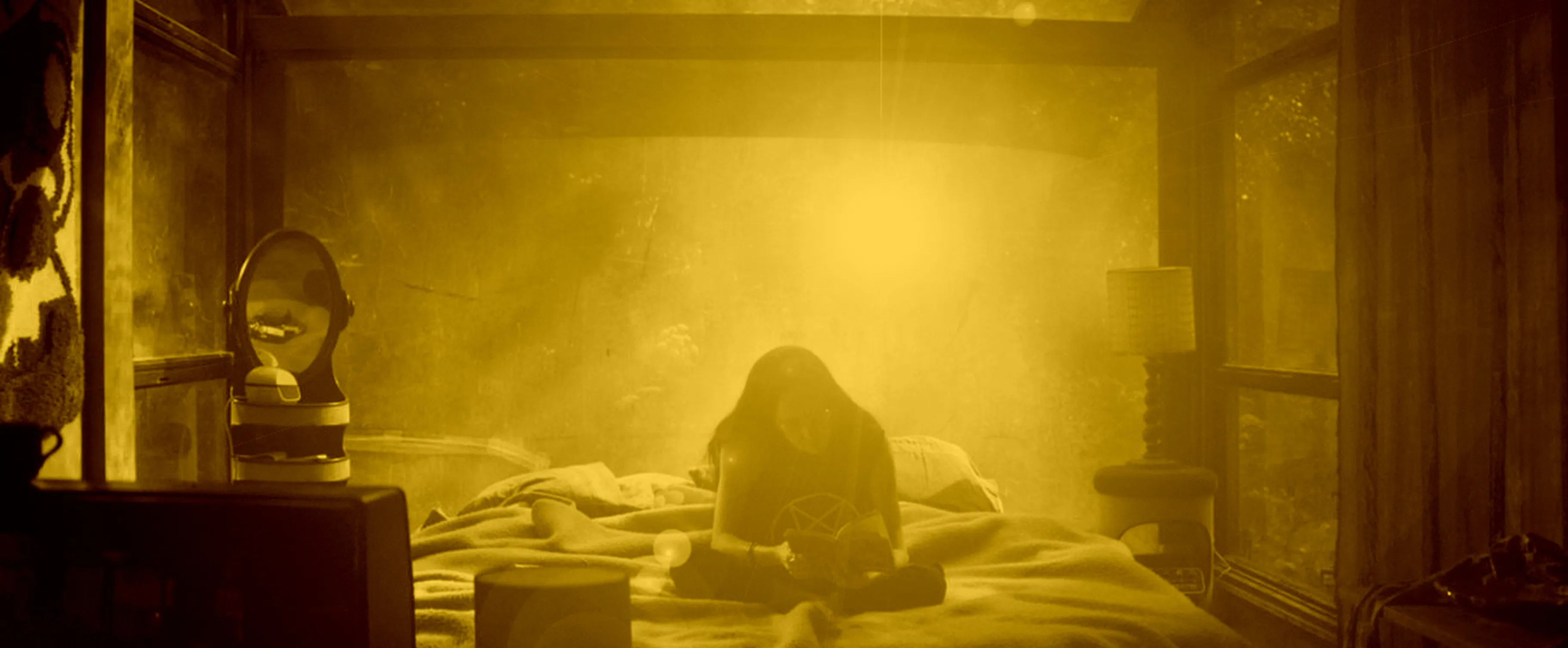
Mandy, dir. Panos Cosmatos, 2018

By Sean Thor Conroe
The author of Fuccboi retreats to a cabin with beers and gummies to more deeply experience films about states of inebriation (and love and grief)
AUTHOR READS
I’ve always thought of myself as Drug-taking Writer Guy.
I’ll do things like tell a story, and then in the middle of the story be like, “And right before I did this, I took these drugs.” I’ve always felt that if one is to commit the self-important sin of writing, one must risk something. Sometimes this has just meant: writing vulnerably. At other times it has meant throwing yourself into the fire in order to test whether you can make it out. And only if you can, can you grant yourself the privilege to write, having done something worth writing about. At still other times it has meant viewing oneself, one’s body, as a vessel for optimal phenomenological engagement—whether through drugs, sleep deprivation or intense physical exertion—for the purpose of achieving a heightened, ecstatic state. A state one must then write from.
In short, I’ve always viewed the recklessness of drug-taking, and the risk involved in writing from altered states, as inextricable from the artistic task.
Three springs ago, a month before my first novel got sold—a recklessly vulnerable novel in which I extoll this ethic of Art over Everything—I lost my two closest friends and artistic collaborators to drug-induced (or strongly drug-influenced) deaths. Both in the same week. When this happened, my view on drugs, on the inherent value of achieving heightened, self-sacrificially ecstatic states for Art’s sake, radically changed. So when I was asked to write a drug-movie essay, I was initially surprised. I don’t know that I romanticize drugs the way I used to. In order to give myself the best chance of writing something Great, I decide to flee the city. To take drugs and self-isolate.
I walk to the smoke shop by my spot, buy two pouches of loose tobacco (~2.5 packs’ worth each), and a 10-count, 100 mg tin of O-ring THC gummies. I pack my truck with a backpack, three tote bags and a boxful of books I might need. Extra clothes, a sleeping bag, some rations (coffee, apples, oatmeal). My notebooks, my laptop, a projector. I arrive at my cousin’s, two hours and change north, by sundown. All set to get glowed, switch off my phone, and go in. I set up my projector, get edibled, tall-boyed, and watch the four films I was set to watch, each correlating to a different drug. Jotting jumbled-up, started-then-abandoned sentences. In a dreamlike daze, unsure whether the drugs are helping or hurting.
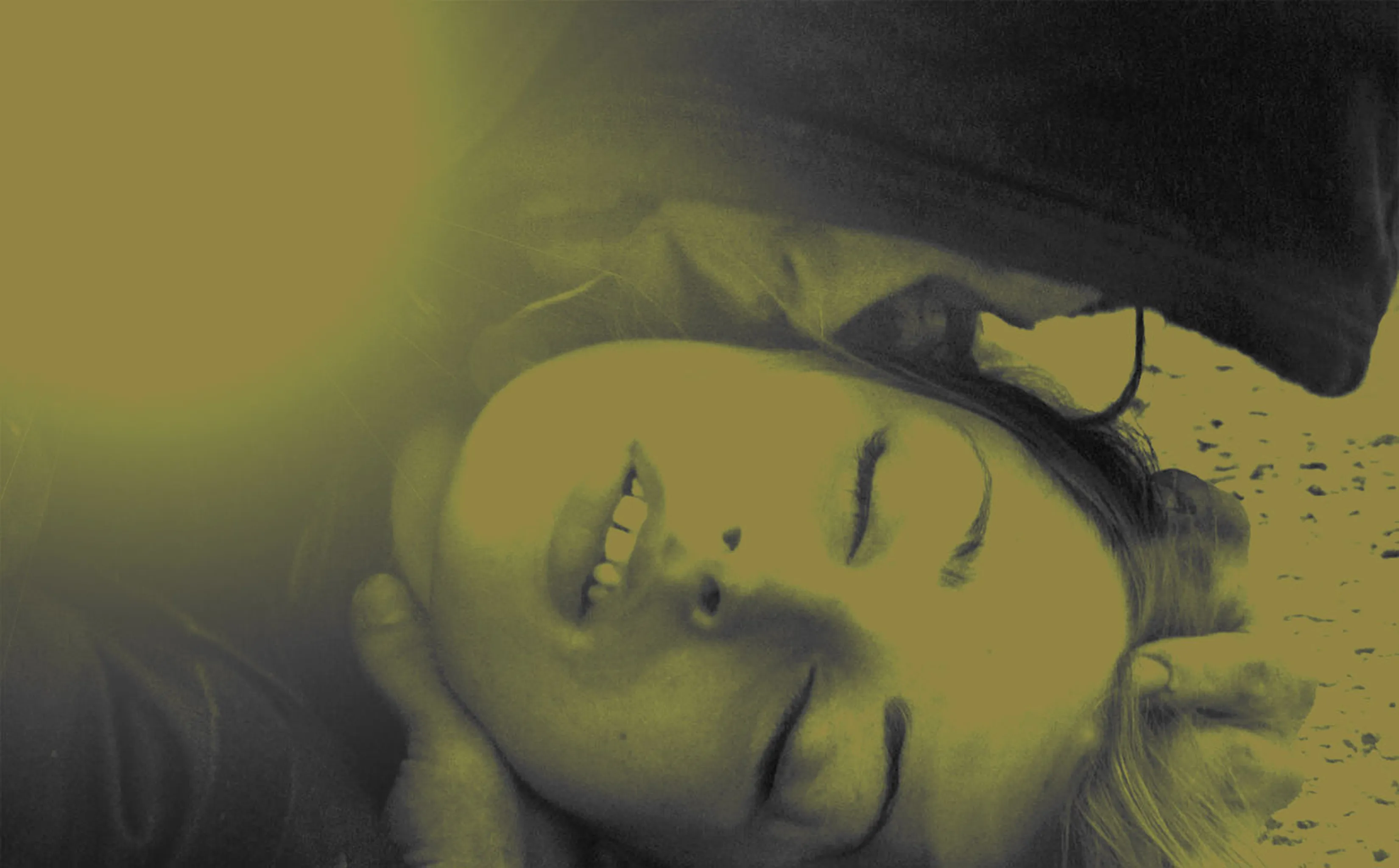
Heaven Knows What, dirs. Benny Safdie and Josh Safdie, 2014
.png)
Heaven Knows What (2014) follows a group of young kids, barely 20, all heroin users, living on the streets of New York City. Scrapping to get their daily doses. Acting self-interestedly and cruel to one another. The movie opens with Harley, the protagonist, basically getting told to take her own life by Ilya, who acts vitriolically cruel to her because, it’s implied, she’s been with men who aren’t him. She asks if she dies will he forgive her? He says yes. Tells her to. Rips up her suicide note. Stuffs the next one she tries to write in her mouth. From the looks of it, he’s on or withdrawing from heroin. Sipping a flask of E&J in the middle of the day. Calling her “a fucking whore,” saying, “Everyone told me that you were a fucking whore.” Telling her to cut herself, then flipping out when she does. I’ve never done heroin, but something about the extreme spikes and dips that result from it seem connected to this type of psychotic cruelty. The times I’ve gotten psychotically possessive over others have coincided with the extreme dips that follow drug binges. Circa 2016, I’d take Adderall every day on my own schedule “to write,” and then, once I’d run out, would take it out on my then-ex, just send her a million messages (we weren’t speaking), thinking it was her, how she was choosing to live her life, however I imagined she was, that she was responsible for how I was feeling.
These scenes of emotional abuse in Heaven Knows What are shot with intense jittery close-ups, often with the subject’s eyes downcast. Early on, they’re all gathered by a bandshell in Central Park, bumping Euro-sounding hardstyle house music, slamming 40s and shooting up. The Safdies’ handheld camcorder quivers and jerks with the crowd. It pans to kids with bad teeth and then bobs from an extreme close-up of Harley’s shaky, chapped hands as she attempts to thread a sewing needle to long shots of frenetic, shadowy figures silhouetted by streetlight. This zoomed-in technique captures the myopia of this mode where you’re technically in the company of others but are concerned only with your own turn-up. Unable to see outside your immediate purview. Harley and Mike start making out on the ground, then the camera reveals Ilya standing there, watching them. Catching both the viewer and the two of them off guard simultaneously. Everyone stuck in their own worlds, preoccupied with their own fixes. Trapped in their own pain. Their love interests inextricable from their daily fixes, looking to each other like drug fixes.
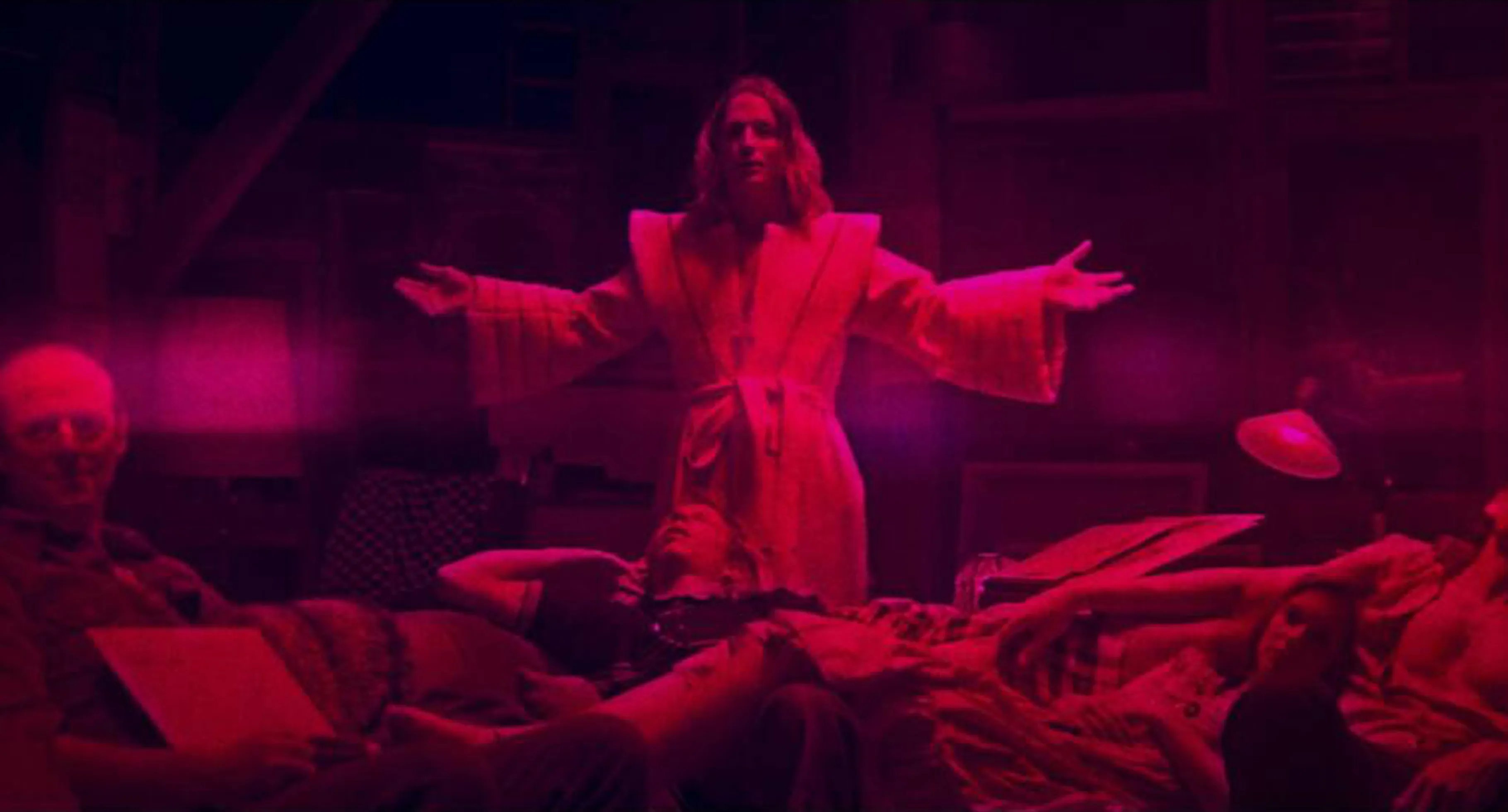
Mandy, dir. Panos Cosmatos, 2018
.png)
In Mandy we see something similar, with people looking to others to feed their needs like a drug. Flipping out when their needs aren’t met.
It follows a dude (Nicolas Cage), a manual laborer, and his girl, Mandy, a fantasy illustrator and convenience-store cashier, living peacefully together in a rural American town. Till one day the leader of a nearby LSD-fueled cult, who doses all his followers, sees Mandy on a road. Gets dead-set on inducting her into his group. Gets his minions to lure her over. They dose her, then the leader creep exposes himself to her. Thinking that, given the drugs, she’ll acquiesce. Despite being barely conscious, given the insane dose they eyedrop into her eye against her will, she doesn’t. She starts laughing hysterically at this sad perverted flaccid man. The spell of the drugs, the cult, gets broken and he flips out. They put her in a burlap sack, hang her up and burn her to death. Mandy is shot stunningly and, I felt, convincingly psychedelically. The colors are surreally heightened, the outer edges of objects appear blurred and buzzing. In especially dosed scenes, there’s a delayed visual trail following objects in motion created through a subtle double exposure, while the vocal tones drop, go slow and distant-sounding. It’s a drug-induced vocal distortion recalling the stimmied-up mother in Requiem for a Dream (2000). In Mandy, however, the effect feels much more menacing, devoid of caricature, as most of these recent movies seem to me, when compared to your classic ’90s and early aughts drug movies—Trainspotting (1996), Fear and Loathing in Las Vegas (1998), even Requiem, which, harrowing as it is, portrays its drug use through a lens of countercultural romanticism. After Mandy gets burned to death, Nicolas Cage grief-chugs half a bottle of vodka, weeps, then rallies. The rest of the movie is Nicolas Cage on a rampage getting revenge.
In the spring of 2017, after breaking up with my then-girl to “go to Humboldt to grow weed,” I moved to Philly. The grow season had ended and I was running back to her. Only, by the time I did, she’d moved on. I was living with a group of friends in a group house, and we wanted to trip together one night, joking that we were a cult and somehow ending up stocking the fridge with way more acid than we could ever do. I was feeling slighted by my ex, was still convinced of myself as “drug guy,” intent on viewing myself as a vessel for any drug that could help me “create Great Art.”
I’d heard of “microdosing,” the writer Ayelet Waldman had published that book about it, and I’d been reading Terence McKenna. I started cutting up tabs and taking ’em daily. Nightly. Sitting out in my van with the windows sealed, all night, writing page after page of my Great Humboldt Novel. After a month of doing that, I’d written the novel to novel length, pronounced it done. I felt disoriented from all the doses, felt weirdly sweaty all the time. Every idea I had seemed to have too much inherent significance; every detour I’d take, worth following. I’d get too preoccupied with my immediate impulses, rather than working patiently toward some coherent Whole. The novel had no coherent threads. It was too disconnected from the world. More, was written on the basis of escaping the reality I was in.
In Mandy, through the lighting and makeup, every one of the cult members’ faces looks perennially greasy and sallow; their postures, slouched; their gazes, dead-eyed. Waiting in a van at night on a dead-end road to meet members of the cult’s biker-gang muscle, the leader’s right-hand man stares transfixed through the windshield while one of his minions keeps lowering and raising the passenger window. Gets transfixed on this pointless act. There’s no external dialogue. Cosmatos lets the silence sit, lets the scene stay static. Whatever, if anything, is happening happens only in their heads.
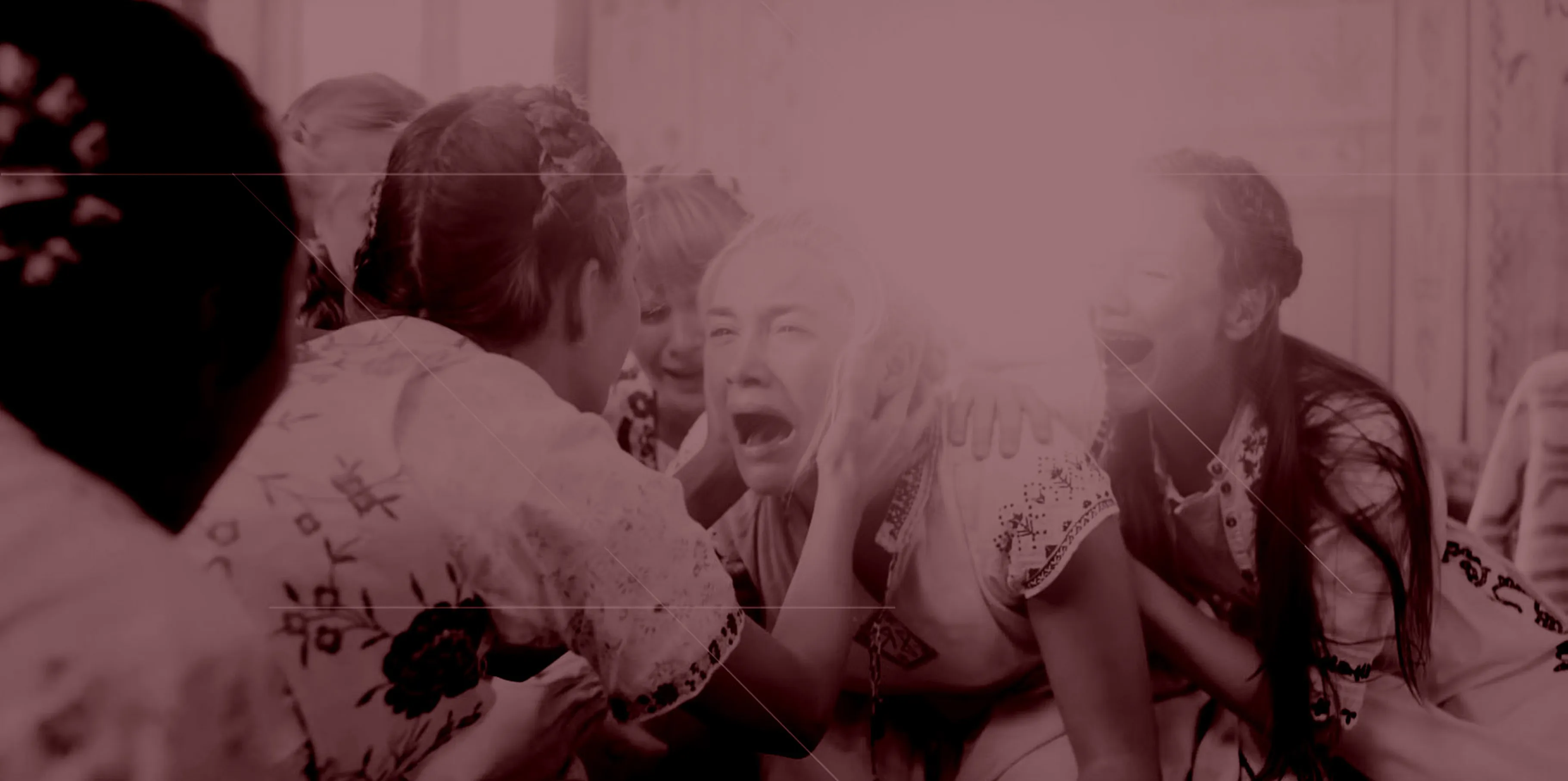
Midsommar, dir. Ari Aster, 2019
.png)
I hadn’t watched, nor heard of, Midsommar (2019) till a month ago. I was talking to a homie about which were the best drug movies, and it was the first one he mentioned. I wanted to watch it, if for no other reason, to talk to him about it.
The movie opens with Dani Ardor, played by Florence Pugh, losing her family to a double murder–suicide by her sister, with the sister gassing their parents in the house they share. When Dani receives a message from her sister, implying that she’s going to do something terrible, Dani’s boyfriend, Christian, accuses her of going “straight to crisis mode.” That the message is “another obvious ploy for attention.”
Dani, Christian and his three grad-school bros then go out to Sweden for a nine-day summer solstice ritual in a small, commune-like village, where one of Christian’s bros, Pelle, is from. What follows is pure horror. They witness an ättestupa ritual, a double suicide-senicide, where the two oldest members of the village fling themselves off a cliff while the others watch, claiming that this is the ethical way for the elderly to end their time on Earth, that to cling to life would “corrupt the spirit.” Having just undergone the death of both parents—a non-ritualistic senicide—witnessing this ritual is insanely triggering for Dani. Having just lost my two closest friends in the same week, witnessing this movie was insanely triggering for me. Right when Dani pulls up to the village, she eats mushrooms with the group. They’re in a field, everything is full of light, it’s Nordic midsummer, the sun never sets, as she comes up she starts to feel like her limbs are plants, two of her boyfriend’s bros keep chattering, this annoys her, she gets up, goes off by herself, feels scared by every group of people she approaches, their faces are moving weird, then runs into a small shed, she sees her sister’s face in the mirror, she flees the shed, runs into the woods, eventually passes out.
The first time I did shrooms I was 20. I’d just finished my first year of undergrad, was just starting up my second. I was up in Vermont in the woods with my good homie and three of his homies, we each ate an eighth, were sitting around a campfire, one of my homie’s bros kept talking, commenting on the experience. I didn’t want to listen to him, to be let into his self-conscious narration of the experience. I wanted direct, unfiltered contact with the experience. I left the group, taking one of the warm rocks from the fire, carried it with me to a tree, held the rock on my tummy like it was my baby, lay in the fetal position on the ground, started getting hit with waves of hilarity at my cosmic smallness, of the absurdity of everything I thought of as “me.” Just lay there buzzing, and at some point, for some reason, took off all my clothes, wanting to feel the warm rock directly against my stomach before eventually finding my way back to the group.
The last time I ate mushrooms I was alone in my apartment as the sun was going down, six months after I lost my two closest friends. I didn’t want to be aware of myself as a cosmically small, narratively held-together self. I wanted my narratives, my goals, my ego-driven delusions to stay intact. I couldn’t understand where my friends had gone, how I’d keep moving forward, as an intact self, with this cognitive dissonance of not knowing where they’d gone. I stayed in the fetal position, in my bed all night, in the dark, shivering, no warm rocks around me, awaiting the sun’s return.
The incommunicability of Dani’s grief, throughout the movie, is conveyed so accurately. From her boyfriend’s impatience and inability to understand what she’s going through, to her terror at walking around on shrooms, to a moment when Pelle brings up the death of her parents, claiming to understand. Since his parents, too, got “burned up in a fire.” The disorientation in Dani’s eyes when she sees Pelle trying to empathize with her. The horror of seeing someone think they can. The reminder that no one ever fully will. She excuses herself, the camera goes god’s-eye view—soul-out-of-body view, looking down directly from above—it starts sounding like she’s on a plane, the sound intensifies like the plane is charging up, taking off, and then, with a thud, she’s inside the bathroom. She slams the door shut, at which point the camera view shifts to reveal she’s in an actual airplane lavatory on a plane—headed out to Sweden, as if the film is looping. Crying again. The waves of grief come in, repeating over and over, every time like you’re back where you started, like no time ever passed.
Midsommar’s ending initially baffled me. The final ceremony is another human sacrifice, where nine members are burned in a house. As the house they’re in is lit, everyone else gathers around and grieves together, yelling and convulsing. Mirroring an earlier moment, when Pelle tells her that that’s what “home” means: never going through anything alone. “Home” means: When you feel something, some crushing pain, everyone feels it with you. “A community that doesn’t bicker over what’s theirs and what’s not theirs,” Pelle says. A community in which he has “always felt held.” An idea mirrored later when Christian gets cajoled into a mating ritual where he impregnates one of Pelle’s sisters; when Dani sees this, she grieves surrounded by a group of women grieving with her; Pelle’s sister, too, as she’s getting impregnated by Christian, is surrounded by women who vocally enter the throes of getting impregnated alongside and around her.
In the final scene, as the sacrificial nine get burned and everyone is grieving together, Dani smiles. I’ve never felt understood after I lost my two closest friends. I’ve only felt alone with my grief, unable to speak on it, knowing no one will understand. On second watch, that was the meaning of the ending. Dani finally “feels held” by a community, finally feels at home.

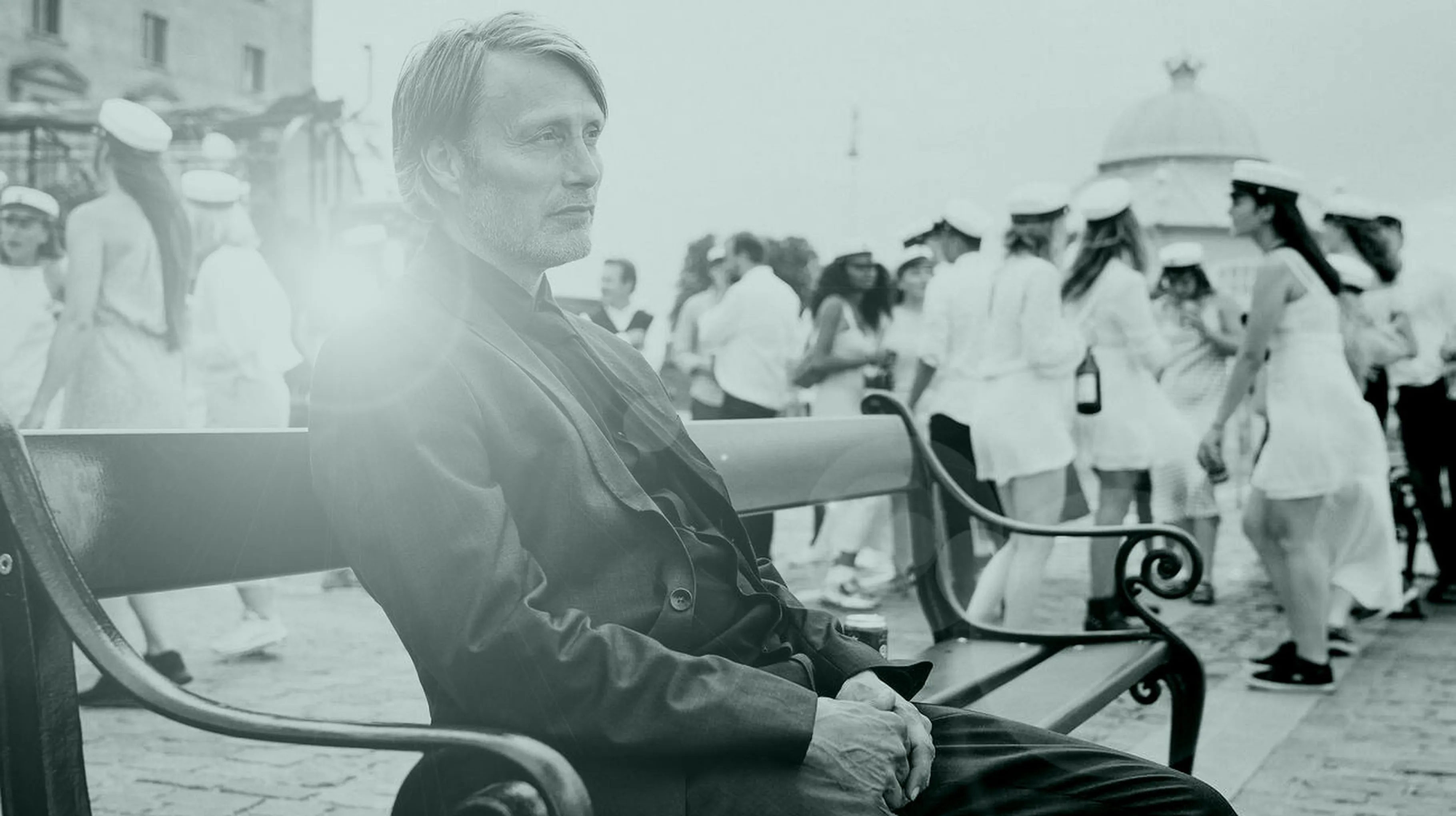
Another Round, dir. Thomas Vinterberg, 2020
.png)
The drug I’ve struggled with most since my novel was published is alcohol. The times I’ve gotten blackout and made an ass of myself over the past year, I was feeling just that: like no one could understand what I was going through, feeling completely and utterly “un-held” by my “community.” I turned to alcohol to erase this feeling. Only, after those nights went so poorly, I started viewing alcohol with rancor and disdain. I went in the opposite direction, to the opposite extreme. Vowing to eschew alcohol, to never engage in ecstatic drug use, to mercilessly judge anyone who did. Or to only get blackout on my own, in solitude—like I, at my cousin’s upstate cabin, was presently doing. To ensure that any lax stance I took toward drugs wouldn’t end catastrophically for someone around me, like I was convinced they would.
Another Round (2020)—or Druk, “binge drinking” in Danish—follows a middle-aged high school history teacher, Martin, and his three friends, also high school teachers, Tommy, Peter and Nikolaj. Martin starts the movie sober, serious and sad. His students complain about his “indifference.” He feels disillusioned with his marriage, with teaching, with his students. Till one day he and his bros learn of this Norwegian psychiatrist, Finn Skårderud, who makes the case that humans function optimally, are “more relaxed and poised and musical and open, more courageous in general,” with a BAC of 0.05%, or on one to two glasses of wine. They decide to try getting slightly tipsy before and during their schooldays to “test this theory.” While, “like Hemingway,” cutting off the booze at 8pm each night. It starts out well. Martin shows up to class lit and rants engagingly and entertainingly. The students love it. In one lecture, he makes the case that Winston Churchill and FDR were constantly slightly lit, whereas Hitler was sober, never drank, suggesting a fascistic streak in a type of neurotic sobriety. The other teachers, too, connect to their students better on the sauce. They up the ante gradually, pushing it to 0.10% BAC, till finally they decide to see how blackout on absinthe they can get. It goes as expected, things go south with Martin and his wife, Nikolaj pisses his bed with his wife in it, and Tommy shows up blackout to a teacher meeting and makes an ass of himself. Like the Safdies, Thomas Vinterberg depicts the lit individual as closed in on himself; while depicting drinkers as more mobile and social than the heroin user—Martin warmly greets the fellow teachers he passes in the halls as he enters the school, which he didn’t do sober—the camera tracks Martin’s drunken movements as he glides this way and that, through the teachers’ lounge, weaving around tables. On his way out, striding confidently, he bashes his face against a door frame neither he nor the viewer saw coming. They decide to stop drinking. Only, Tommy, the gym teacher, can’t stop. He keeps drinking in solitude. Gets put on administrative leave by the school. Gets in his boat with his dog one day and floats himself out to sea.
In the final scene, after Tommy’s funeral, despite Tommy's having died an alcohol-related death, they drink together. To honor his memory. To connect with each other. They don’t go to either extreme, don’t either black out their pain at his loss or go neurotically sober. Martin, mildly buzzed off some sparkling wine, starts texting with his wife again. He connects with his friends, starts dancing. He drinks, nondestructively, exuberantly, to connect with his community.
My isolated, upstate bender comes to an end. My cousin is about to come back to reclaim his home. I’ve got a lot of notes, some vague paragraphs, but no Great Drug Essay to show for it. I wake up on my final morning, do my most steady drug routine—a pot of coffee first thing, over-smoke from the last of my second tobacco pouch—and get to tidying his spot. I turn my phone back on. I pack up my truck, lock up, drive back to the city. I link up with a friend, have a mellow, calm, communal night over one to two slowly sipped glasses of wine. I drink just enough to better connect with her.
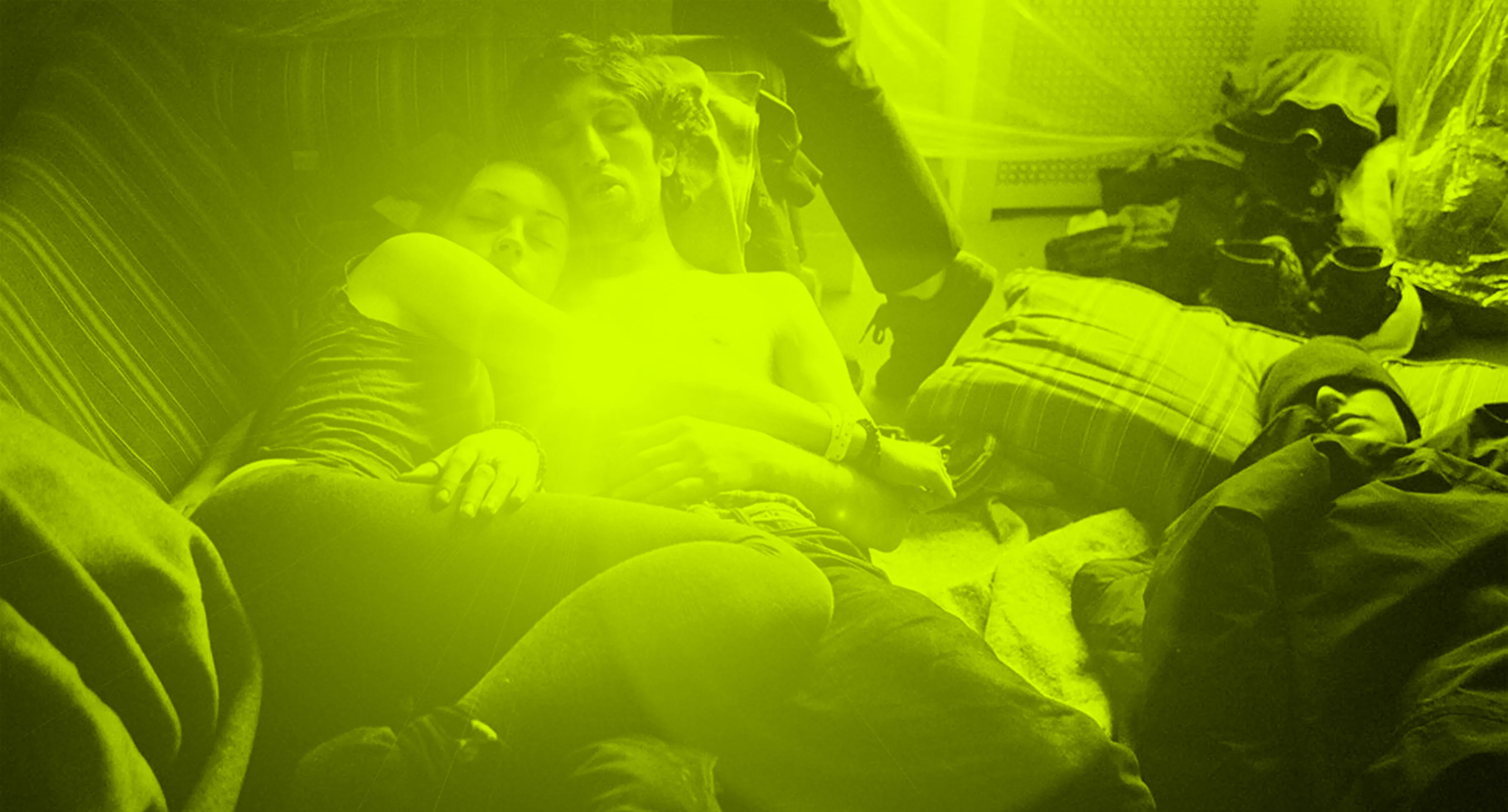
From left: Arielle Holmes and Buddy Duress in Heaven Knows What

Despite the horrific way their relationship starts in Heaven Knows What, the end of the movie finds Harley and Ilya back in love and on a bender. They get loaded and flee the city together. The intensity of their love is amplified by their mutual escapism, their mutual litness. The drugs heighten the intensity of their love. Only, when they come down, Ilya erratically ditches Harley while she’s sleeping, crashes out in an abandoned house, a candle falls over, and he burns to death. It’s not Harley’s fault, though, that that happened. No one can control anyone else’s actions.
In my favorite scene from Heaven Knows What, Harley is with Mike, the other boy she likes. They’re meeting with a drug dealer to try to score. Mike doesn’t have enough money, so he goes around the corner to get more, leaving Harley with the drug dealer, a hot cool guy with a motorcycle. She asks him if he knows any tricks. Sure I do, he says, doing some wheelies. Then goes, “What are you doing right now? Come for a ride with me.” She says she’s not doing anything. She wants to. She starts donning his extra helmet right when Mike shows back up. Mike and the dealer do the deal. Then Harley goes, “I’m gonna go for a ride.” Mike starts flipping out. “Have you ever rode a motorcycle before?… Do you know how many people I know died breaking their necks?” Like he’s “protecting” her. The dealer goes, “Dude, she’ll be fine.” Harley goes, “I’ll see you later, all right?” Then they take off, leaving Mike standing there all mad.
The thing is, he can’t stop her from going for a ride. Even if he did, he wouldn’t be able to control whether or not she died. Trying to control her wouldn’t stop anything that was gonna happen from happening. Sometimes “going for a ride” just means “going for a ride.” Doesn’t mean anything catastrophic. And she doesn’t die. They go whizzing down the BQE in the shoulder lane. It’s an exhilarating, ecstatic, psychically heightened shot.
A drug-like yet drug-free, phenomenologically optimal experience.